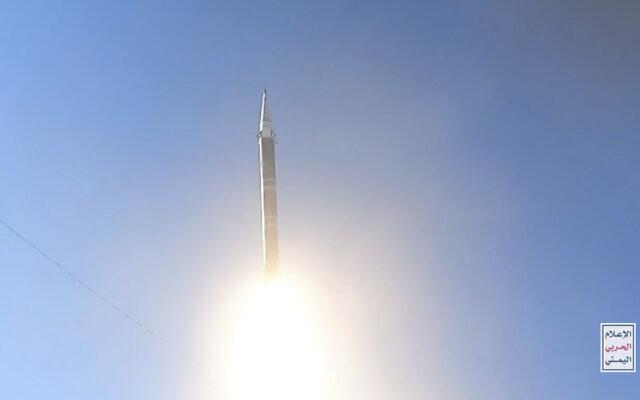
Houthis unveil solid-fuel ‘Palestine’ that resembles Iranian hypersonic missile
Yemen’s Houthi rebels have unveiled a new, solid-fuel missile in their arsenal that resembles aspects of one earlier displayed by Iran that Tehran described as flying at hypersonic speeds.
The rebels fired its new “Palestine” missile, complete with a warhead painted like a Palestinian keffiyeh checkered scarf, at the southern Gulf of Aqaba port of Eilat in Israel on Monday. The attack set off air raid sirens but caused no reported damage or injuries.
The IDF said at the time that a surface-to-surface missile, fired “from the direction of the Red Sea,” was headed toward Israel, likely aimed for Eilat, when it was shot down using the advanced Arrow system.
Footage released by the Houthis late Wednesday showed the Palestine being raised on what appeared to be a mobile launcher and rising quickly into the air with plumes of white smoke coming from its engine. White smoke is common with solid-fuel missiles.
Solid-fuel missiles can be set up and fired faster than those containing liquid fuel. That’s a key concern for the Houthis as their missile launch sites have been repeatedly targeted by US and allied forces in recent months over the rebels’ attacks on shipping through the Red Sea corridor. One such strike hit the Houthis even before they were able to launch their missile.
For their part, the Houthis described the Palestine as a “locally made” missile. However, the Houthis are not known to possess the ability to manufacture complicated missile and guidance systems locally in Yemen, the Arab world’s poorest country, which has been gripped by war since the rebels seized the capital, Sanaa, nearly a decade ago.
The Houthis have, however, been repeatedly armed by Iran during the war despite a United Nations arms embargo. While Iran claims it doesn’t arm the Houthis, ships seized by the US and its allies have found Iranian weaponry, missile fuel and components on board.
Iranian media reported the launch of the Palestine and described it as locally manufactured, citing the Houthis. However, some design elements of the missile resemble other missiles developed by Iran’s paramilitary Revolutionary Guard. That includes one called the Fattah, or “Conqueror” in Farsi.
Iran unveiled the missile last year and claimed it could reach Mach 15 — or 15 times the speed of sound. It also described the missile’s range as up to 1,400 kilometers (870 miles). That’s a little short of Eilat from Houthi-controlled areas of Yemen, but the missiles can be reconfigured to boost their range.
In March, Russia’s state-run RIA Novosti news agency quoted an anonymous source claiming the Houthis had a hypersonic missile.
“While we cannot say for sure what exact version the ‘Palestine’ corresponds to, we can say with high certainty that it is an advanced and precision-guided (Guard)-developed solid propellant missile provided by Iran,” wrote Fabian Hinz, a missile expert and research fellow at the International Institute for Strategic Studies.
Iran’s mission to the United Nations did not immediately respond to a request for comment about the similarity between the Palestine and its missiles.
Hypersonic weapons, which fly at speeds higher than Mach 5, could pose crucial challenges to missile defense systems because of their speed and maneuverability.
Ballistic missiles fly on a trajectory in which anti-missile systems like the US-made Patriot can anticipate and intercept them. The more irregular the missile’s flight path, such as a hypersonic missile with the ability to change directions, the more difficult it becomes to intercept.
China is believed to be pursuing the weapons, as is America. Russia claims it has already used them.
It remains unclear how well the Palestine maneuvers and at what speed it travels.
Source » timesofisrael.com





